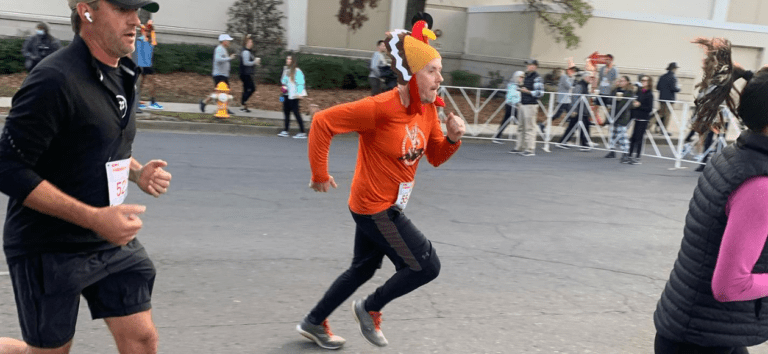The weather is cooling off and the days are getting shorter. For the running community, that can only mean one thing…Turkey Trot season is coming.
Thanksgiving Day has evolved as the largest single running day in the United States, with well over a million participants in Turkey Trots across the country. In 2019, RunSignup alone hosted 488 individual Thanksgiving Day races, with more than half a million participants. But with rolling restrictions on gatherings and continued uncertainty about COVID-19 in the fall, what does that mean for your Turkey Trot?
Turkey Trots ARE Happening
Whether in-person, virtual, or a hybrid of the two, no one is giving up on the Thanksgiving Day tradition. More than 180 Thanksgiving Day races have already opened registration on RunSignup, and we are seeing more each day.
Plan for All Possibilities.
Yes, all of them – a backup for your backup’s backup.
- Plan A (in-person, with no alterations) is unlikely for most races.
- Plan B accounts for social distancing and safety protocols and includes a hybrid model with a virtual option for those who aren’t able or willing to attend in person
- Plan C makes the switch to fully virtual to accommodate size limits and other local restrictions, and the cost increases that can come with them
- Plan D brings a creative eye, adapting to the pandemic by scraping your “normal” and putting together a Virtual Challenge or fundraising-only event that appeals to your specific supporters
We have the go-ahead for In-Person. What’s the point of including a virtual option?
Congratulations! Putting on an in-person event is every organizers dream right now. But including a virtual component can help in several ways:
- Reduced Travel. Turkey Trots are tailor-made for families from different areas that gather for the holidays – a virtual option preserves some “togetherness”
- Concerns over personal safety will keep some people home – but they may still want to keep the tradition alive, and will be more willing to participate on their own.
- Encourage earlier registration. Many people may be hesitant to register if they don’t know if they’ll be able to travel or gather. They’re more likely to commit if they know the virtual option is a back-up if their comfort level changes.
- Size restrictions are likely in many jurisdictions and can change financial calculations. Some costs are scalable to your number of runners, but others (like permits) stay the same even if you’re only allowed half the runners. Virtual runners can help balance the books.
- Nothing is certain. It’s chaotic to switch a fully in-person event to virtual. Having the virtual option in place makes a last-minute change easier to handle.
What should I be doing NOW?
Talk to everyone: governing bodies, venues, park official, vendors, medical support, police, and sponsors. Assess your options and calculate your costs.
Being allowed to proceed in person doesn’t necessarily mean it’s the best option. Make a real analysis of your budget, including additional expenses for PPP and staff hours and a reduced number of allowed participants, and evaluate if you can break even.

If you don’t think you can break even, that doesn’t mean you have to cancel. You may be able to adjust your prices, add a virtual option to supplement, or change some of your normal perks – in most cases, runners will understand.
Marketing a Turkey Trot in 2020
Turkey Trots hold a unique place in people’s hearts – and that’s an asset that can help you market under challenging circumstances. Lean on these pillars to encourage people to support you, even if it’s virtually.
- Tradition. Families running and walking together is a common holiday tradition – remind them that they can continue that tradition, even if they can’t travel to be together. Take tradition a step further by recognizing your long-term participants (those who have joined for 5, 10, or 20 years) and encourage them to keep the streak alive.
- Community. People want to support local businesses that are hurting. Give extra exposure to your local sponsors, and create a RaceJoy Anywhere map with audio cheers and waypoints showing off local slang and establishments.
- Cause. If you are a nonprofit, or support one, remind people that that need still exists – and that the charity relies on events to fund their annual budget. Online fundraising is easy and safe and offers a simple way for the community to support the mission.
Referrals, referrals, referrals. Referral Rewards, always an effective marketing strategy, have become even more key since March. Referrals regularly make up 18-20% of registrations for virtual races, with some events seeing a rate as high as 40% from referrals. Turn on referral tracking, enable referral reward refunds, and use automated registration follow-up emails to remind your participants to refer.
Want more marketing advice? Download the Virtual Race Marketing Checklist for marketing best practices that can grow your event – whether in-person, virtual, or hybrid.
What Else Should I Be Doing?
- Talk to your Sponsors (and we don’t mean email).
- Make a plan for Swag. Shipping is a pain. Make sure you’re prepared for it – or get help. Ask your timer if they offer swag fulfillment and shipping, or check out these vendors who do.
- Learn from others. We have a few races that you can draw inspiration from – both in-person events that added modifications for safety and permitting and hybrid events that offer both in-person and virtual options.
Browse all our tips and recommendations for planning a Turkey Trot (or other hybrid event) in 2020.
